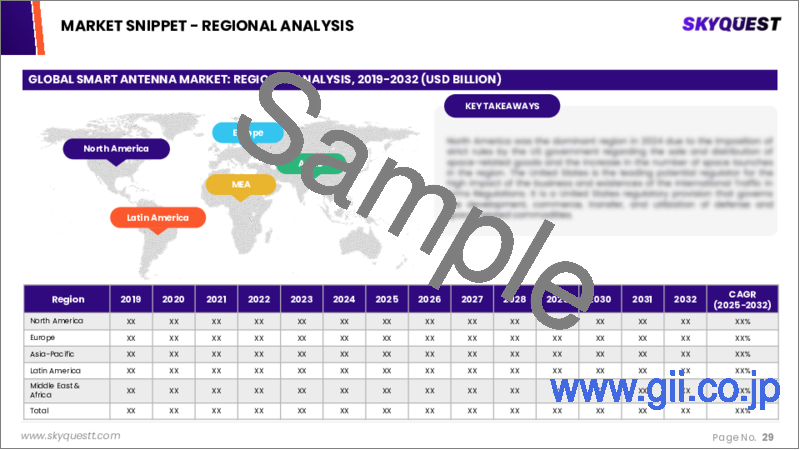|
|
市場調査レポート
商品コード
1603307
スマートアンテナの市場規模、シェア、成長分析、タイプ別、技術別、製品別、用途別、地域別 - 産業予測、2024年~2031年Smart Antenna Market Size, Share, Growth Analysis, By Type, By Technology, By Product, By Application, By Region - Industry Forecast 2024-2031 |
||||||
|
|||||||
| スマートアンテナの市場規模、シェア、成長分析、タイプ別、技術別、製品別、用途別、地域別 - 産業予測、2024年~2031年 |
|
出版日: 2024年11月25日
発行: SkyQuest
ページ情報: 英文 250 Pages
納期: 3~5営業日
|
全表示
- 概要
- 目次
世界のスマートアンテナの市場規模は、2022年に23億米ドルとなり、2023年の25億米ドルから、2031年までには58億米ドルに成長し、予測期間中(2024年~2031年)のCAGRは10.9%で成長する見通しです。
スマートアンテナの世界市場は、急速な技術進歩やさまざまな分野でのデータトランスミッションの高速化需要の高まりによって大きな成長を遂げています。スマートアンテナシステムは、複数のアンテナ部品と高度な信号処理機能を統合したもので、周囲の信号に基づいて放射パターンと受信パターンを自動的に調整し、性能を最適化することで無線通信を強化します。これらのシステムは、送信側と受信側の両方に配備することができ、固有の空間シグネチャによって個々のユーザーを識別できるため、ネットワークのスループットが向上します。高速インターネットや高度な接続機能を必要とするスマートフォン、ノートパソコン、パーソナルデジタルアシスタントなどのデバイスの普及は、業界の拡大にさらに貢献しています。また、スマートアンテナは、マルチアクセス干渉の管理、通信距離の延長、電力の制御、信号のフェージングやマルチパスの問題の軽減にも不可欠です。さらに、商用車と乗用車の両方で衛星ナビゲーションと車両ネットワーキングの強化に使用される車載用スマートアンテナの進歩は、重要な成長分野を示しています。同市場は、ITセクターの急速な拡大や、スマートアンテナ技術の強化を目的とした広範な研究開発努力から恩恵を受けると予想されます。全体として、さまざまなアプリケーションでスマートアンテナの統合が進んでいることは、現代の通信インフラの形成における重要な役割を反映し、市場の将来が有望であることを示しています。
目次
イントロダクション
- 調査の目的
- 調査範囲
- 定義
調査手法
- 情報調達
- 二次データと一次データの方法
- 市場規模予測
- 市場の前提条件と制限
エグゼクティブサマリー
- 世界市場の見通し
- 供給と需要の動向分析
- セグメント別機会分析
市場力学と見通し
- 市場概要
- 市場規模
- 市場力学
- 促進要因と機会
- 抑制要因と課題
- ポーター分析と影響
- 競争企業間の敵対関係
- 代替品の脅威
- 買い手の交渉力
- 新規参入業者の脅威
- 供給企業の交渉力
主要な市場の考察
- 主要な成功要因
- 競合の程度
- 主要な投資機会
- 市場エコシステム
- 技術の進歩
- 規制情勢
- バリューチェーン分析
- ケーススタディ分析
- 顧客と購買基準の分析
- PESTEL分析
- マクロ経済指標
- 貿易分析
- スタートアップ分析
- 市場の魅力指数
- 原材料の分析
- サプライチェーン分析
- 価格分析
世界のスマートアンテナ市場規模:タイプ別・CAGR(2024年~2031年)
- 市場概要
- スイッチビームスマートアンテナ
- アダプティブアレイスマートアンテナ
- FPCスマートアンテナ
- LDSスマートアンテナ
- MPIスマートアンテナ
- LCPスマートアンテナ
世界のスマートアンテナ市場規模:技術別・CAGR(2024年~2031年)
- 市場概要
- SIMO(単一入力、複数出力)
- MIMO(複数入力、複数出力)
- MISO(複数入力、単一出力)
世界のスマートアンテナ市場規模:製品別・CAGR(2024年~2031年)
- 市場概要
- スマートTV
- 電話
- ラップトップ
- ワイヤレスオーディオ
- タブレット
- ウェアラブル
- デスクトップ
世界のスマートアンテナ市場規模:用途別・CAGR(2024年~2031年)
- 市場概要
- Wi-Fiシステム
- セルラーシステム
- WiMAXシステム
- RADARシステム
- その他
世界のスマートアンテナ市場規模・CAGR(2024年~2031年)
- 北米(タイプ、技術、製品、用途)
- 米国
- カナダ
- 欧州(タイプ、技術、製品、用途)
- 英国
- ドイツ
- スペイン
- フランス
- イタリア
- その他欧州地域
- アジア太平洋(タイプ、技術、製品、用途)
- 中国
- インド
- 日本
- 韓国
- その他アジア太平洋
- ラテンアメリカ(タイプ、技術、製品、用途)
- ブラジル
- その他ラテンアメリカ地域
- 中東・アフリカ(タイプ、技術、製品、用途)
- GCC諸国
- 南アフリカ
- その他中東・アフリカ
競合情報
- 上位5社の比較
- 主要企業の市場ポジショニング(2023年)
- 主要な市場企業が採用した戦略
- 市場の最近の動向
- 企業の市場シェア分析(2023年)
- 主要企業の企業プロファイル
- 会社概要
- 製品ポートフォリオ分析
- 企業のセグメント別シェア分析
- 収益の前年比比較(2021年~2023年)
主要企業プロファイル
- CONTINENTAL AG
- DENSO CORPORATION
- FORVIA
- TE CONNECTIVITY
- FICOSA INTERNACIONAL SA
- HARADA INDUSTRY CO., LTD.
- KATHREIN SOLUTIONS GMBH
- ROBERT BOSCH GMBH
- LAIRD CONNECTIVITY
- YOKOWO CO., LTD.
- SCHAFFNER HOLDING AG
- HIRSCHMANN CAR COMMUNICATION GMBH
- HARMAN INTERNATIONAL
- TAOGLAS LTD.
- AIRGAIN
- INPAQ TECHNOLOGY CO., LTD.
- ANOKIWAVE, INC.
- CALEARO ANTENNE SPA
- ANTENOVA LTD.
- YAGEO GROUP
結論と提言
Global Smart Antenna Market size was valued at USD 2.3 billion in 2022 and is poised to grow from USD 2.5 billion in 2023 to USD 5.8 billion by 2031, growing at a CAGR of 10.9% during the forecast period (2024-2031).
The global smart antenna market is experiencing significant growth driven by rapid technological advancements and the increasing demand for faster data transmission across various sectors. Smart antenna systems, which integrate multiple antenna components with sophisticated signal processing capabilities, enhance wireless communication by automatically adjusting their radiation and reception patterns to optimize performance based on surrounding signals. These systems can be deployed at both the transmitter and receiver ends, enabling the differentiation of individual users through their unique spatial signatures, thereby improving network throughput. The proliferation of devices such as smartphones, laptops, and personal digital assistants, which require high-speed internet and advanced connectivity features, further contributes to the industry's expansion. Smart antennas are also essential for managing multiple access interference, extending range, controlling power, and mitigating signal fading and multipath issues. Furthermore, the advancement of automotive smart antennas, used for satellite navigation and enhancing vehicle networking in both commercial and passenger vehicles, represents a crucial growth area. The market is anticipated to benefit from the rapid expansion of the IT sector and extensive research and development efforts aimed at enhancing smart antenna technology. Overall, the increasing integration of smart antennas in various applications signals a promising future for the market, reflecting its vital role in shaping modern communication infrastructure.
Top-down and bottom-up approaches were used to estimate and validate the size of the Global Smart Antenna market and to estimate the size of various other dependent submarkets. The research methodology used to estimate the market size includes the following details: The key players in the market were identified through secondary research, and their market shares in the respective regions were determined through primary and secondary research. This entire procedure includes the study of the annual and financial reports of the top market players and extensive interviews for key insights from industry leaders such as CEOs, VPs, directors, and marketing executives. All percentage shares split, and breakdowns were determined using secondary sources and verified through Primary sources. All possible parameters that affect the markets covered in this research study have been accounted for, viewed in extensive detail, verified through primary research, and analyzed to get the final quantitative and qualitative data.
Global Smart Antenna Market Segmental Analysis
Global Smart Antenna Market is segmented by Type, Technology, Product, Application and region. Based on Type, the market is segmented into Switched Beam Smart Antenna, Adaptive Array Smart Antenna, Adaptive Array Smart Antenna, LDS Smart Antenna, MPI Smart Antenna, LCP Smart Antenna. Based on Technology, the market is segmented into SIMO (Single Input Multiple Output), MIMO (Multiple Input Single Output), MISO (Multiple Input Multiple Output). Based on Product, the market is segmented into Smart TV, Phone, Laptop, Wireless Audio, Tablet, Wearables, Desktop. Based on Application, the market is segmented into Wi-Fi Systems, Cellular Systems, WiMAX Systems, RADAR Systems, Others. Based on region, the market is segmented into North America, Europe, Asia Pacific, Latin America and Middle East & and Africa.
Driver of the Global Smart Antenna Market
A primary factor fueling the expansion of the global smart antenna market is the growing need for superior communication quality, driven by an upsurge in the number of wireless devices. Most Wi-Fi and cellular networks operate within a frequency range of 800MHz to 3GHz, which allows for effective propagation and a broad selection of components. This trend towards increased reliance on wireless communication systems is expected to bolster the adoption of smart antennas in the coming years. Moreover, the emergence of smart buildings and cities presents additional opportunities for market players. The key benefits of smart antennas, including minimized signal fading, efficient power control, extended range, decreased multiple access interference, and improved multipath management, have led to their rising popularity, particularly with the increasing use of smartphones.
Restraints in the Global Smart Antenna Market
The growth of the Global Smart Antenna market may be hindered by several constraints, primarily the elevated costs associated with production and ongoing maintenance. These high expenses can pose significant barriers to widespread adoption. Additionally, the technology still faces numerous technical challenges during the installation process, as it continues to evolve through research and development. Such issues may lead to delays and complications, further restricting market growth. Therefore, while the potential for smart antennas is considerable, these factors could significantly impede their overall market penetration and commercial viability in the near future.
Market Trends of the Global Smart Antenna Market
The Global Smart Antenna market is witnessing a significant trend driven by the urgent need for enhanced communication capabilities across various industries, particularly in the rapidly evolving Indian market. As businesses and sectors upgrade from traditional antenna systems to advanced smart antennas, there is a surge in the development of innovative use cases tailored for the information and communications technology (ICT) sector. This transition not only promises improved network performance and efficiency but also supports the increasing demand for high-speed data and connectivity services. Consequently, the market is expected to expand robustly, reflecting a broader global shift towards smarter, more efficient communication infrastructures.
Table of Contents
Introduction
- Objectives of the Study
- Scope of the Report
- Definitions
Research Methodology
- Information Procurement
- Secondary & Primary Data Methods
- Market Size Estimation
- Market Assumptions & Limitations
Executive Summary
- Global Market Outlook
- Supply & Demand Trend Analysis
- Segmental Opportunity Analysis
Market Dynamics & Outlook
- Market Overview
- Market Size
- Market Dynamics
- Driver & Opportunities
- Restraints & Challenges
- Porters Analysis & Impact
- Competitive rivalry
- Threat of substitute
- Bargaining power of buyers
- Threat of new entrants
- Bargaining power of suppliers
Key Market Insights
- Key Success Factors
- Degree of Competition
- Top Investment Pockets
- Market Ecosystem
- Technological Advancement
- Regulatory Landscape
- Value Chain Analysis
- Case Study Analysis
- Customer & Buying Criteria Analysis
- PESTEL Analysis
- Macro-Economic Indicators
- Trade Analysis
- Startup Analysis
- Market Attractiveness Index
- Raw Material Analysis
- Supply Chain Analysis
- Pricing Analysis
Global Smart Antenna Market Size by Type & CAGR (2024-2031)
- Market Overview
- Switched Beam Smart Antenna
- Adaptive Array Smart Antenna
- FPC Smart Antenna
- LDS Smart Antenna
- MPI Smart Antenna
- LCP Smart Antenna
Global Smart Antenna Market Size by Technology & CAGR (2024-2031)
- Market Overview
- SIMO (Single Input Multiple Output)
- MIMO (Multiple Input Multiple Output)
- MISO (Multiple Input Single Output)
Global Smart Antenna Market Size by Product & CAGR (2024-2031)
- Market Overview
- Smart TV
- Phone
- Laptop
- Wireless Audio
- Tablet
- Wearables
- Desktop
Global Smart Antenna Market Size by Application & CAGR (2024-2031)
- Market Overview
- Wi-Fi Systems
- Cellular Systems
- WiMAX Systems
- RADAR Systems
- Others
Global Smart Antenna Market Size & CAGR (2024-2031)
- North America, (Type, Technology, Product, Application)
- US
- Canada
- Europe, (Type, Technology, Product, Application)
- UK
- Germany
- Spain
- France
- Italy
- Rest of Europe
- Asia-Pacific, (Type, Technology, Product, Application)
- China
- India
- Japan
- South Korea
- Rest of Asia Pacific
- Latin America, (Type, Technology, Product, Application)
- Brazil
- Rest of Latin America
- Middle East & Africa, (Type, Technology, Product, Application)
- GCC Countries
- South Africa
- Rest of Middle East & Africa
Competitive Intelligence
- Top 5 Player Comparison
- Market Positioning of Key Players, 2023
- Strategies Adopted by Key Market Players
- Recent Developments in the Market
- Company Market Share Analysis, 2023
- Company Profiles of All Key Players
- Company Details
- Product Portfolio Analysis
- Company's Segmental Share Analysis
- Revenue Y-O-Y Comparison (2021-2023)
Key Company Profiles
- CONTINENTAL AG
- Company Overview
- Business Segment Overview
- Financial Updates
- Key Developments
- DENSO CORPORATION
- Company Overview
- Business Segment Overview
- Financial Updates
- Key Developments
- FORVIA
- Company Overview
- Business Segment Overview
- Financial Updates
- Key Developments
- TE CONNECTIVITY
- Company Overview
- Business Segment Overview
- Financial Updates
- Key Developments
- FICOSA INTERNACIONAL SA
- Company Overview
- Business Segment Overview
- Financial Updates
- Key Developments
- HARADA INDUSTRY CO., LTD.
- Company Overview
- Business Segment Overview
- Financial Updates
- Key Developments
- KATHREIN SOLUTIONS GMBH
- Company Overview
- Business Segment Overview
- Financial Updates
- Key Developments
- ROBERT BOSCH GMBH
- Company Overview
- Business Segment Overview
- Financial Updates
- Key Developments
- LAIRD CONNECTIVITY
- Company Overview
- Business Segment Overview
- Financial Updates
- Key Developments
- YOKOWO CO., LTD.
- Company Overview
- Business Segment Overview
- Financial Updates
- Key Developments
- SCHAFFNER HOLDING AG
- Company Overview
- Business Segment Overview
- Financial Updates
- Key Developments
- HIRSCHMANN CAR COMMUNICATION GMBH
- Company Overview
- Business Segment Overview
- Financial Updates
- Key Developments
- HARMAN INTERNATIONAL
- Company Overview
- Business Segment Overview
- Financial Updates
- Key Developments
- TAOGLAS LTD.
- Company Overview
- Business Segment Overview
- Financial Updates
- Key Developments
- AIRGAIN
- Company Overview
- Business Segment Overview
- Financial Updates
- Key Developments
- INPAQ TECHNOLOGY CO., LTD.
- Company Overview
- Business Segment Overview
- Financial Updates
- Key Developments
- ANOKIWAVE, INC.
- Company Overview
- Business Segment Overview
- Financial Updates
- Key Developments
- CALEARO ANTENNE SPA
- Company Overview
- Business Segment Overview
- Financial Updates
- Key Developments
- ANTENOVA LTD.
- Company Overview
- Business Segment Overview
- Financial Updates
- Key Developments
- YAGEO GROUP
- Company Overview
- Business Segment Overview
- Financial Updates
- Key Developments






